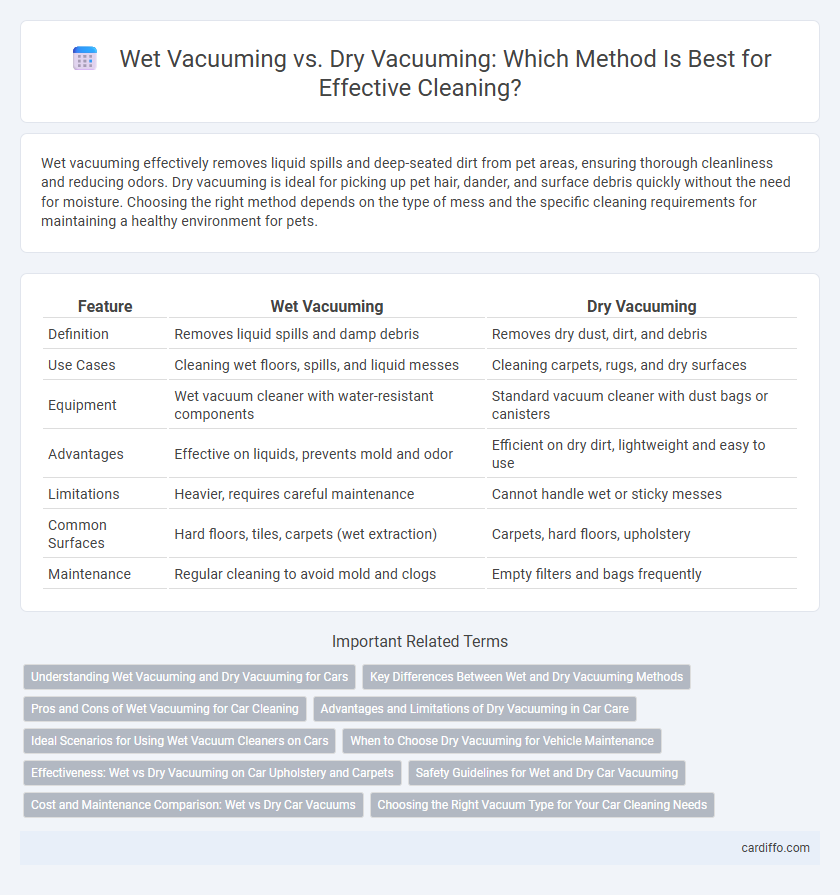Wet vacuuming effectively removes liquid spills and deep-seated dirt from pet areas, ensuring thorough cleanliness and reducing odors. Dry vacuuming is ideal for picking up pet hair, dander, and surface debris quickly without the need for moisture. Choosing the right method depends on the type of mess and the specific cleaning requirements for maintaining a healthy environment for pets.
Table of Comparison
| Feature | Wet Vacuuming | Dry Vacuuming |
|---|---|---|
| Definition | Removes liquid spills and damp debris | Removes dry dust, dirt, and debris |
| Use Cases | Cleaning wet floors, spills, and liquid messes | Cleaning carpets, rugs, and dry surfaces |
| Equipment | Wet vacuum cleaner with water-resistant components | Standard vacuum cleaner with dust bags or canisters |
| Advantages | Effective on liquids, prevents mold and odor | Efficient on dry dirt, lightweight and easy to use |
| Limitations | Heavier, requires careful maintenance | Cannot handle wet or sticky messes |
| Common Surfaces | Hard floors, tiles, carpets (wet extraction) | Carpets, hard floors, upholstery |
| Maintenance | Regular cleaning to avoid mold and clogs | Empty filters and bags frequently |
Understanding Wet Vacuuming and Dry Vacuuming for Cars
Wet vacuuming for cars efficiently removes liquid spills, mud, and sticky residues by using water and cleaning solutions, making it ideal for deep cleaning upholstery and carpets. Dry vacuuming captures dust, dirt, and loose debris from surfaces without moisture, preserving sensitive materials and preventing mold growth. Choosing between wet and dry vacuuming depends on the type of dirt present and the car's interior material, ensuring optimal cleanliness and maintenance.
Key Differences Between Wet and Dry Vacuuming Methods
Wet vacuuming effectively removes liquid spills and damp debris, making it ideal for water damage or deep cleaning carpets, while dry vacuuming excels at collecting dust, dirt, and dry particles on hard floors and upholstery. Wet vacuums often feature waterproof components and stronger suction to handle moisture without damage, whereas dry vacuums typically use paper or cloth filters to trap fine dust and allergens. Maintenance differs as wet vacuums require careful emptying of liquid tanks and cleaning to prevent mold, contrasting with dry vacuums that mainly need dust bag replacement or filter cleaning.
Pros and Cons of Wet Vacuuming for Car Cleaning
Wet vacuuming for car cleaning effectively removes stubborn dirt, spilled liquids, and pet hair, enhancing interior hygiene and preventing mold growth. It requires more maintenance and drying time compared to dry vacuuming, potentially leading to moisture retention if not properly handled. Wet vacuum cleaners often have heavier equipment and higher initial costs, but provide a deeper clean on fabric seats and carpets.
Advantages and Limitations of Dry Vacuuming in Car Care
Dry vacuuming in car care effectively removes loose dirt, dust, and debris from upholstery and carpets without the risk of moisture damage, preserving the interior's fabric integrity. It offers quick cleanup and prevents mold or mildew formation that can result from wet cleaning methods, making it ideal for routine maintenance. However, dry vacuuming is less effective at removing stains or sticky residues, requiring supplementary cleaning techniques for deep sanitation.
Ideal Scenarios for Using Wet Vacuum Cleaners on Cars
Wet vacuum cleaners are ideal for removing spills, mud, and pet hair from car interiors, especially on fabric seats and floor mats. They efficiently extract moisture and stubborn dirt from carpets, providing a deep clean that dry vacuums cannot achieve. Using wet vacuums helps prevent mold growth and keeps the car interior smelling fresh after liquid contamination.
When to Choose Dry Vacuuming for Vehicle Maintenance
Dry vacuuming is ideal for routine vehicle maintenance as it effectively removes dust, dirt, and debris from carpets, upholstery, and hard surfaces without causing moisture damage. It helps maintain interior cleanliness and prevents mold growth, making it suitable for delicate materials and electrical components. Choose dry vacuuming when the vehicle interior is visibly dry and requires regular upkeep.
Effectiveness: Wet vs Dry Vacuuming on Car Upholstery and Carpets
Wet vacuuming effectively removes deep-seated dirt, stains, and moisture from car upholstery and carpets, eliminating allergens and bacteria more efficiently than dry vacuuming. Dry vacuuming excels at capturing surface dust, pet hair, and loose debris but often misses embedded particles and fails to address odors caused by spills. Combining both methods maximizes cleanliness, but for heavy soiling and moisture-related issues, wet vacuuming provides superior results.
Safety Guidelines for Wet and Dry Car Vacuuming
Wet vacuuming requires using vacuums specifically designed for liquid pickup to prevent electrical hazards and ensure proper drainage, while dry vacuuming involves avoiding liquids to reduce the risk of motor damage and fire. Always inspect the vacuum for damage, use appropriate attachments, and wear protective gloves when handling wet debris in cars to reduce exposure to harmful contaminants. Proper ventilation and regular cleaning of vacuum filters and tanks help maintain device performance and minimize health risks during both wet and dry car vacuuming.
Cost and Maintenance Comparison: Wet vs Dry Car Vacuums
Wet vacuums typically demand higher initial investment and more frequent maintenance due to their complex components designed to handle liquids, resulting in additional costs for filters and bladder replacements. Dry vacuums generally offer lower upfront prices and simpler upkeep with fewer parts prone to damage, making them more cost-effective over time. Choosing between wet and dry car vacuums involves balancing the higher expense and maintenance of wet units against the efficient, economical nature of dry models.
Choosing the Right Vacuum Type for Your Car Cleaning Needs
Wet vacuuming excels at removing liquid spills and deep-seated dirt, making it ideal for thorough car interior cleaning and tackling stubborn stains. Dry vacuuming efficiently captures loose debris, dust, and pet hair from carpets and upholstery without moisture. Selecting the right vacuum depends on your car's specific cleaning needs, with wet vacuums suited for damp messes and dry vacuums optimal for routine maintenance.
Wet vacuuming vs Dry vacuuming Infographic

 cardiffo.com
cardiffo.com